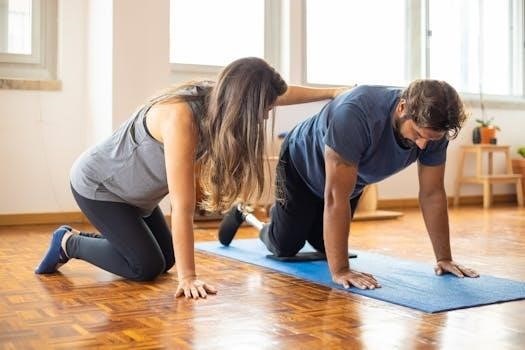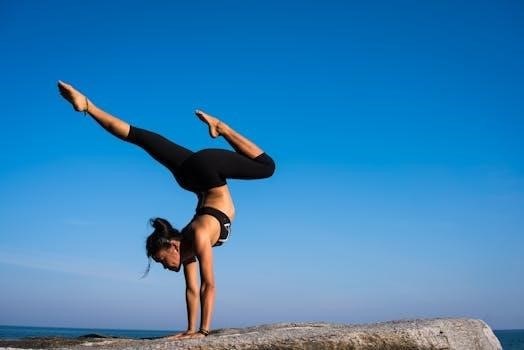What is a Core Workout?
A core workout focuses on strengthening the muscles around your trunk, including abdominals, back, and pelvis. It goes beyond just targeting the “six-pack” and aims to improve stability, balance, and overall functional strength. These exercises are essential for daily activities and injury prevention.
Understanding the Core’s Function
The core is more than just your abs; it’s a complex network of muscles that work together to stabilize and support your spine. These muscles include the deep abdominals, obliques, erector spinae, and even muscles in your hips and pelvis. The core acts as a bridge, transferring forces between your upper and lower body during movement. It enables you to maintain proper posture, balance, and control during various activities. A strong core is crucial for everyday actions, like walking, lifting, and twisting, as well as more intense physical activities. Understanding the core’s function also involves recognizing the importance of spinal stability, achieved through proper core engagement. This prevents injury and allows for efficient movement patterns. Training the core effectively requires focusing on exercises that challenge these muscles in a balanced and controlled manner, rather than just isolating the superficial muscles. It is important to use proper technique, maintaining a neutral spine and engaging the core throughout the movement.

Benefits of a Strong Core
A strong core provides numerous advantages, including improved posture and balance. It also leads to reduced back pain and a decreased risk of injuries. Core strength enhances athletic performance and daily functional movements.
Improved Posture and Balance
A strong core is fundamental for maintaining good posture and balance. The core muscles act as a natural corset, supporting the spine and keeping the body upright. When these muscles are weak, it can lead to slouching, rounded shoulders, and an unstable center of gravity. By engaging in core-strengthening exercises, individuals can improve their postural alignment, which not only enhances physical appearance but also reduces strain on the neck, back, and other joints. Furthermore, a strong core contributes to better balance, reducing the risk of falls and injuries. This is particularly beneficial for older adults and those involved in activities requiring agility and stability. Core exercises help to develop the deep muscles that stabilize the spine and pelvis, allowing for smoother and more controlled movements. In essence, improved posture and balance are direct results of a well-trained core, leading to better overall body mechanics and functional abilities in daily life and athletic pursuits. The ability to maintain a neutral spine is also key, and core exercises help to train this posture.
Reduced Back Pain
One of the most significant benefits of a strong core is the reduction of back pain. The core muscles play a crucial role in supporting the spine, and when these muscles are weak, the spine becomes vulnerable to injury and pain. By engaging in regular core exercises, individuals can strengthen these muscles, creating a natural support system for the back. This improved support helps to alleviate pressure on the spinal discs, ligaments, and joints, reducing the likelihood of back pain. Core exercises also promote better posture, which is another key factor in preventing back problems. Poor posture can strain the back muscles, leading to discomfort and pain. Strengthening the core helps individuals maintain a more neutral spine, reducing the stress on the back. Moreover, core exercises improve the overall stability and strength of the trunk, allowing for better movement and reduced risk of injury during daily activities. Many individuals find relief from chronic back pain through a dedicated core-strengthening routine, highlighting the importance of a strong core for spinal health and pain management. Deep abdominal activation is also key to preventing back issues.

Core Exercises
Effective core exercises include planks, dead bugs, crunches, reverse crunches, and knee-to-elbow movements. These exercises target various core muscles, promoting overall strength and stability. A variety of exercises is key for a well-rounded core workout.
Plank Variations
Plank variations are excellent for core strengthening, offering a range of options to challenge different muscle groups. The basic plank, performed with forearms on the ground and the body in a straight line, is a foundational exercise. To increase difficulty, try forearm plank with hip dips, moving your hips side to side while maintaining the plank position. Another variation is the plank with alternating leg lifts, where you raise one leg at a time. Side planks, either on the hand or forearm, target the obliques. Plank jacks involve jumping the legs out and back in, adding a cardio element. For a more advanced challenge, consider the plank with shoulder taps, alternating tapping each shoulder with the opposite hand. Remember to maintain a neutral spine and engage your core throughout all plank variations. These variations ensure that all areas of the core are worked and that the user is always progressing in their level of exercise. It’s important to start with basic planks and then gradually add the variations.
Dead Bug Exercise
The dead bug exercise is a fantastic core strengthener that emphasizes stability and coordination. Start by lying on your back with your arms extended towards the ceiling and your knees bent at a 90-degree angle. Engage your core by pressing your lower back into the mat. Slowly lower one arm towards the floor while simultaneously extending the opposite leg out, keeping both just above the ground. Maintain the core engagement throughout the movement to prevent lower back arching. Inhale as you lower your arm and leg, and exhale as you return to the starting position. Alternate sides with each repetition, maintaining a steady and controlled tempo. The key is to keep your core muscles engaged and your lower back pressed firmly against the floor. This exercise works the deep abdominal muscles and promotes spinal stability. It is very important to do this exercise slowly and deliberately. The dead bug exercise is also useful for improving coordination.
Crunches and Reverse Crunches
Crunches and reverse crunches are classic core exercises that target the abdominal muscles, although they work slightly different areas. For a standard crunch, lie on your back with your knees bent and feet flat on the floor, placing your hands behind your head, gently supporting it. Engage your core and lift your head and shoulders off the floor, focusing on bringing your ribcage towards your pelvis. Avoid pulling on your neck. Lower back down slowly to the starting position. Reverse crunches, on the other hand, start with you lying on your back with your knees bent at a 90 degree angle, hips and knees positioned up toward the ceiling. Engage your core and lift your hips and lower back off the floor, bringing your knees towards your chest. Control the movement both ways, avoiding swinging. These exercises can be effective for targeting the upper and lower abs, but are not a complete core workout. Remember to maintain proper form and controlled movements.
Knee to Elbow Movements
Knee to elbow movements are dynamic core exercises that engage the obliques and abdominals while also improving coordination and balance. There are a few variations of this exercise, including standing, lying, and plank positions. One common variation involves lying on your back with your hands behind your head, similar to a standard crunch position. Bring one knee up towards your chest while simultaneously lifting your upper body and rotating your torso to bring the opposite elbow towards the knee. The other leg extends out, but does not need to touch the floor. Alternate sides in a controlled manner, maintaining a steady rhythm. Another variation can be done in a plank position, where you bring one knee towards the opposite elbow, alternating sides while keeping your body in a straight line from head to heels. These movements are great for adding a rotational element to core workouts, which is important for functional movement. Focus on controlled movements and core engagement throughout.

Proper Core Engagement
Proper core engagement is crucial for effective workouts and injury prevention. It involves activating the deep abdominal muscles to stabilize the spine. This is achieved by drawing your navel towards your spine, while maintaining a neutral spine position.
Neutral Spine and Pelvic Tilt
Understanding neutral spine and pelvic tilt is fundamental for safe and effective core training. A neutral spine refers to the natural curvature of your spine when you’re standing or lying down, avoiding excessive arching or rounding. Pelvic tilt, on the other hand, involves the movement of your pelvis forward or backward. To find neutral spine, imagine your pelvis is a bowl of water; you want to keep the water from spilling out the front or back. This is your starting position for many core exercises.
Pelvic tilt is controlled through core muscle activation, allowing you to protect your lower back during movements. Anterior pelvic tilt is when the pelvis tips forward, increasing the arch in your lower back, while posterior pelvic tilt occurs when the pelvis tips backward, flattening the lower back. During core exercises, a slight posterior tilt is often recommended to engage the abdominal muscles effectively and maintain spinal stability. Practicing this control helps you perform movements safely, reducing the risk of injury.

Core Workout PDF Resources
Looking for a structured plan? Many websites and healthcare providers offer downloadable PDF guides for core workouts. These resources provide visual aids, instructions, and exercise progressions, making them a great tool.
Downloadable Exercise Guides
Numerous resources offer downloadable PDF exercise guides, which provide a structured approach to core training. These guides often include detailed instructions and visual aids, making them accessible for various fitness levels. You can find guides from reputable sources such as healthcare providers, fitness organizations, and academic institutions. Many of these guides incorporate a variety of core exercises, encompassing different levels of difficulty and targeting specific muscle groups within the core. Some guides are designed for beginners, while others are tailored for more advanced individuals. Typically, these downloadable resources include progressions, allowing you to gradually increase the intensity and complexity of your workouts. They often provide clear explanations on proper form and technique, which is essential for preventing injuries. Additionally, they may include tips on core engagement and breathing techniques. These guides are a convenient way to access information and create a personalized core workout plan. It’s recommended to choose a guide that aligns with your fitness level and goals, ensuring a safe and effective training experience. These resources are often free and can be easily accessed online, providing a cost-effective way to enhance your fitness routine.
